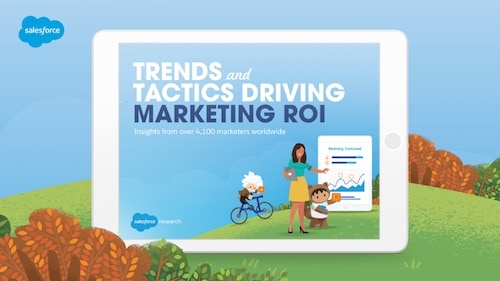Marketers now assume a larger role in business-wide customer experience initiatives. As their responsibilities evolve from pure lead generation to encompass more of the customer journey, the definition of success is changing, affecting how marketing metrics are analyzed.
To uncover the latest in marketing metrics, as well as which programs and channels generate the most ROI, Salesforce Research surveyed 4,100+ global marketing leaders for their perspectives. You can find the results in our new report Trends and Tactics Driving Marketing ROI, but here’s a peek at some of the key findings.
Which marketing metrics are the most important to track?
Increasing sales remains marketers’ core mission. Accordingly, the most popular marketing metrics are revenue growth and sales effectiveness, like direct involvement in opportunities and qualitative sales feedback.
However, the amount of data available to marketers is increasing at a tremendous pace, along with new advanced tools and methods for analyzing data. This has opened the door for marketers to track metrics that are more sophisticated, granular, and customer-focused than before.
For instance, 43% of marketers currently track lifetime customer value (LTV), and an additional 46% plan to track it, representing 107% projected growth. Compared to simpler metrics like lead counts and page views, LTV offers a holistic view of the customer relationship — from discovery through advocacy — and is calculated by synthesizing the new data available to marketers — online and offline engagement, average order value, order frequency, and so on.

Which marketing metrics are used and where?
Leads are still king and are thus the primary metric to gauge the effectiveness of an overall marketing program. When it comes to brand building, however, marketers mainly assess performance through customer satisfaction metrics like net promoter score (NPS). It’s no secret that customer reviews and social feedback are typically a few clicks away — or that customer experience regularly makes or breaks brands. In fact, 84% of customers say experiences provided by a company are as important as its products and services — a number that’s risen year-over-year.
Also interesting to note is the popularity of cost per lead (CPL) for lead generation and customer acquisition cost (CAC) for customer acquisition. This nods to the increased analytic capabilities available to marketers for improving not only customer experiences but also internal operations.

How leaders track marketing metrics
Web analytics and ad channel platforms top the list of technologies and methods marketers use to measure success. However, right behind are more sophisticated technologies — like data management platforms (DMPs) and marketing analytics platforms — that analyze data from multiple sources, bringing marketers closer to the elusive 360-degree customer view.
Traditionally leveraged by advertising teams to optimize media buying, DMP use cases are expanding to encompass content personalization, identity resolution, and more. As data sources proliferate and customer demands continue to climb, marketers anticipate their adoption of DMPs to jump by 64% by 2020.

How AI affects marketing
Any study on big trends shaking up the marketing world would be remiss without mention of artificial intelligence (AI). Twenty-nine percent of marketing organizations have adopted AI, and an additional 46% are piloting or planning to use it within two years. Of those marketers using AI, 88% claim at least moderate ROI from their investment, with over half reporting major ROI.
A majority of customers now expect personalized, real-time engagement — something that’s traditionally a challenge to deliver at scale. Powered by growing access to rich data sources, AI helps marketers deliver instant engagement on customers’ channels of choice that is reflective of personal preferences and past behavior. Brands use AI, for instance, to update website content based on previous interactions, to suggest timely and relevant offers, to create Siri-like experiences with chatbots, and more.

Find out more
Our recent research into marketing metrics goes deeper than what’s covered here. Check out the links below to learn more about how to take your marketing measurement to the next level.
- Read the report Trends & Tactics Driving Marketing ROI
- Register for our upcoming webcast




























